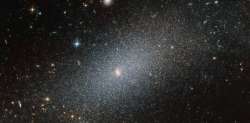7 breathtaking space photos taken this week will blow your mind
Skygazing is becoming more and more of a hobby by the day. People are also now more inclined to see the extraordinary images taken in space from high-quality cameras of NASA.

Skygazing is becoming more and more of a hobby by the day. People are also now more inclined to see the extraordinary images taken in space from high-quality cameras of NASA.
Here are 7 images from this week that will blow your mind
On July 18, 2020, astrophotographer Evan Zucker and his wife, Paula, drove three hours to the Mojave Desert north of Desert Center, California, to see Comet NEOWISE. "The comet itself was a very obvious naked-eye object, even all the way down to the horizon, but the ion tail was a challenge to perceive naked eye," Zucker wrote on Facebook.
On July 16, when the European Space Agency (ESA) and NASA unveiled the latest images captured by their Solar Orbiter mission, some viewers pointed out the small, dark blotch on the left-hand side in one of the image sequences. The tardigrade-shaped speck in the imagery recently led to some joking about the unlikely solar presence of a water bear, reports Space.com.
NASA astronaut Doug Hurley snapped this incredible shot of the Sobradinho Reservoir and São Francisco River in Brazil from the International Space Station and posted it to Twitter on July 21. Hurley flew to the space station May 30 aboard SpaceX's Crew Dragon vehicle Endeavour as part of the Demo-2 mission and is set to return to Earth on August 2, reports Space.com.
While it might look like a cosmic, space brain, this is actually an image of G292.0+1.8, a young, oxygen-rich remnant from a supernova that scientists think has a pulsar at its center, surrounded by outflowing material. The image, taken by NASA's Chandra X-ray Observatory
Observations using Chandra have created strong evidence that there is a pulsar in G292.0+1.8. Using observations like this, astronomers can study the connection between pulsars (a magnetized, rotating neutron star that emits electromagnetic radiation) and massive stars.
In this image, you can see a shell of expanding gas 36 light-years across. The gas contains elements including oxygen, neon, magnesium, silicon and sulfur, reports Space.com.
A sparkling galaxy shines in this image from the NASA/ESA Hubble Space Telescope. The galaxy, known as PGC 29388, glimmers amidst a sea of more distant galaxies. It is a dwarf elliptical galaxy, named as such because it is “small” (relatively speaking) with “only” about 100 million to a few billion stars, reports space.com.
NASA's Mars Reconnaissance Orbiter (MRO) captured this view of the Jezero Crater, the landing site for the Perseverance Mars rover. This Martian crater offers an optimal landing site, as it has geologically rich terrain dating as far back as 3.6 billion years old.
"On ancient Mars, water-carved channels and transported sediments to form fans and deltas within lake basins," NASA officials said in a statement. "Examination of spectral data acquired from orbit show that some of these sediments have minerals that indicate chemical alteration by water. Here in Jezero Crater delta, sediments contain clays and carbonates." — Samantha Mathewson
The JIRAM instrument aboard NASA's Juno spacecraft took these images on Dec. 26, 2019. They provide the first infrared mapping of Ganymede's northern regions. The $1.1 billion Juno probe launched in August 2011 and arrived at Jupiter in July 2016 on a mission to help scientists better understand the giant planet and its moons.